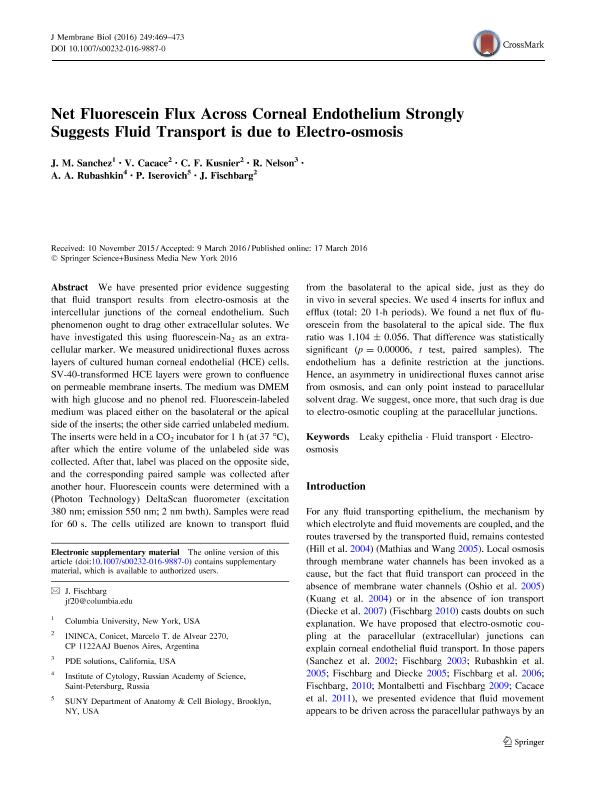Artículo
Net Fluorescein Flux Across Corneal Endothelium Strongly Suggests Fluid Transport is due to Electro-osmosis
Sanchez, J. M.; Cacace, Verónica Inés ; Kusnier, Carlos Federico
; Kusnier, Carlos Federico ; Nelson, R.; Rubashkin, A. A.; Iserovich, P.; Fischbarg, Jorge
; Nelson, R.; Rubashkin, A. A.; Iserovich, P.; Fischbarg, Jorge
 ; Kusnier, Carlos Federico
; Kusnier, Carlos Federico ; Nelson, R.; Rubashkin, A. A.; Iserovich, P.; Fischbarg, Jorge
; Nelson, R.; Rubashkin, A. A.; Iserovich, P.; Fischbarg, Jorge
Fecha de publicación:
08/2016
Editorial:
Springer
Revista:
Journal of Membrane Biology
ISSN:
0022-2631
Idioma:
Inglés
Tipo de recurso:
Artículo publicado
Clasificación temática:
Resumen
We have presented prior evidence suggesting that fluid transport results from electro-osmosis at the intercellular junctions of the corneal endothelium. Such phenomenon ought to drag other extracellular solutes. We have investigated this using fluorescein-Na2 as an extracellular marker. We measured unidirectional fluxes across layers of cultured human corneal endothelial (HCE) cells. SV-40-transformed HCE layers were grown to confluence on permeable membrane inserts. The medium was DMEM with high glucose and no phenol red. Fluorescein-labeled medium was placed either on the basolateral or the apical side of the inserts; the other side carried unlabeled medium. The inserts were held in a CO2 incubator for 1 h (at 37 °C), after which the entire volume of the unlabeled side was collected. After that, label was placed on the opposite side, and the corresponding paired sample was collected after another hour. Fluorescein counts were determined with a (Photon Technology) DeltaScan fluorometer (excitation 380 nm; emission 550 nm; 2 nm bwth). Samples were read for 60 s. The cells utilized are known to transport fluid from the basolateral to the apical side, just as they do in vivo in several species. We used 4 inserts for influx and efflux (total: 20 1-h periods). We found a net flux of fluorescein from the basolateral to the apical side. The flux ratio was 1.104 ± 0.056. That difference was statistically significant (p = 0.00006, t test, paired samples). The endothelium has a definite restriction at the junctions. Hence, an asymmetry in unidirectional fluxes cannot arise from osmosis, and can only point instead to paracellular solvent drag. We suggest, once more, that such drag is due to electro-osmotic coupling at the paracellular junctions.
Palabras clave:
Electro-Osmosis
,
Fluid Transport
,
Leaky Epithelia
Archivos asociados
Licencia
Identificadores
Colecciones
Articulos(ININCA)
Articulos de INST.DE INVEST.CARDIOLOGICAS (I)
Articulos de INST.DE INVEST.CARDIOLOGICAS (I)
Citación
Sanchez, J. M.; Cacace, Verónica Inés; Kusnier, Carlos Federico; Nelson, R.; Rubashkin, A. A.; et al.; Net Fluorescein Flux Across Corneal Endothelium Strongly Suggests Fluid Transport is due to Electro-osmosis; Springer; Journal of Membrane Biology; 249; 4; 8-2016; 469-473
Compartir
Altmétricas



